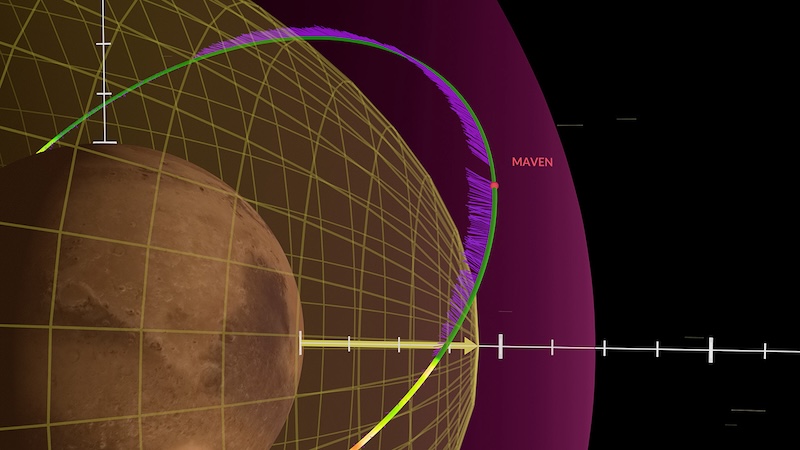On December 26, 2022, the solar wind around Mars suddenly “disappeared”, from the perspective of NASA’s MAVEN orbiter. As the solar wind density dropped, both Mars’ atmosphere and magnetosphere swelled, expanding like a balloon for thousands of kilometers. Video via NASA Goddard Space Flight Center.
The solar wind pours outward from our star at supersonic speeds. It’s a stream of charged particles, flowing through our solar system, buffeting the planets. Most of the time, the solar wind is fairly steady. But on December 26, 2022, NASA’s MAVEN orbiter noticed something odd. The solar wind around Mars suddenly “disappeared.” How was that possible? On December 11, 2023, NASA said that a unique circumstance in the solar wind was responsible. And something else happened, too. As a result of the decreased solar wind, both Mars’ atmosphere – the ionosphere, specifically – and magnetosphere expanded like a balloon, for thousands of kilometers.
Jasper Halekas at the University of Iowa is the lead author of a new peer-reviewed paper. He discussed the unusual event and the science results at the fall meeting of the American Geophysical Union (AGU23), held in San Francisco earlier this month.
The 2024 lunar calendars are here! Best New Year’s gifts in the universe! Check ’em out here.
Mars and the solar wind
When the solar wind reaches Mars, it exerts pressure on both the atmosphere and magnetosphere. The wind hits the outer ionosphere portion of the atmosphere, causing some particles to escape into space. This is a daily occurrence, since the solar wind never stops.
Therefore, Mars is always immersed in the solar wind, just like the Earth and other planets. But what would happen if the solar wind did stop, or at least diminish?
The day the solar wind disappeared at Mars
That is exactly what occurred on December 26, 2022. For some reason, the solar wind suddenly decreased significantly. As Halekas said:
When we first saw the data, and how dramatic the drop in the solar wind was, it was almost unbelievable. We formed a working group to study the event, and we have found this time period to be rich with incredible findings.
MAVEN is unique in that it is the only orbiter that can simultaneously observe both the sun’s activity and the response of the Martian atmosphere at the same time. MAVEN’s instruments detected many fewer particles in the solar wind than usual hitting Mars at the time.
What caused it?
So, what caused the solar wind to suddenly “disappear?” Mission scientists said it was a unique solar event. Faster-moving solar wind overtook slower-moving solar wind. This event – known as a stream interaction region – swept the two winds together, compressing them. The rare occurrence subsequently left behind a void of low-density solar wind. This is what MAVEN observed.

Mars’ atmosphere swells like a balloon
But something else happened, too. Since the solar event had created a void, there were far fewer solar wind particles hitting Mars’ atmosphere. In fact, the density of the solar wind dropped by a factor of 100. This meant less pressure being exerted on the atmosphere. As a result, both the ionosphere and magnetosphere tried to fill the void, expanding outward for thousands of kilometers, like a balloon. Overall, they more than tripled their normal size.
In addition, the event even affected the sun’s magnetic field. Typically, it interacts with and is embedded within Mars’ ionosphere. But when the solar wind decreased, the sun’s magnetic field was pushed outward. That, in turn, changed the ionosphere from magnetized to unmagnetized.
There is also a layer between the solar wind and Mars’ magnetosphere. During this event, it became electromagnetically quiet.
A rare phenomenon
The solar wind has disappeared like this before, but it is an extremely rare occurrence. When it does happen, it is when solar activity on the sun increases. Indeed, this is the first time that MAVEN observed this happening since it arrived at Mars on September 21, 2014. Shannon Curry, principal investigator for MAVEN at the University of California, Berkeley, said:
Observing extreme conditions is always scientifically invaluable. MAVEN was designed to observe these types of interactions between the sun and the Martian atmosphere, and the spacecraft provided exceptional data during this truly anomalous solar event.
The atmosphere that Mars has now is minuscule to what it used to have billions of years ago. In 2015, MAVEN provided more evidence that solar winds initially stripped the planet of most of its atmosphere. Now, only a very thin remnant remains.
Indeed, MAVEN’s observations are helping scientists better understand both the Martian atmosphere and the sun. Gina DiBraccio is the MAVEN deputy principal investigator at NASA’s Goddard Space Flight Center in Greenbelt, Maryland. She said:
This really shows the cross-divisional role that MAVEN plays at Mars. MAVEN is not only observing the dynamics of the Martian atmosphere, it is also monitoring solar inputs to enhance our understanding of the sun.
Bottom line: In mid-December 2023, at the American Geophysical Union meeting in San Francisco, scientists discussed a rare “disappearance” of the solar wind at the planet Mars.
Source: The Day the Solar Wind Disappeared at Mars
Read more: Solar wind likely stripped Martian atmosphere
Read more: Solar wind sandblasts Mercury
The post The day the solar wind disappeared at Mars first appeared on EarthSky.
0 Commentaires